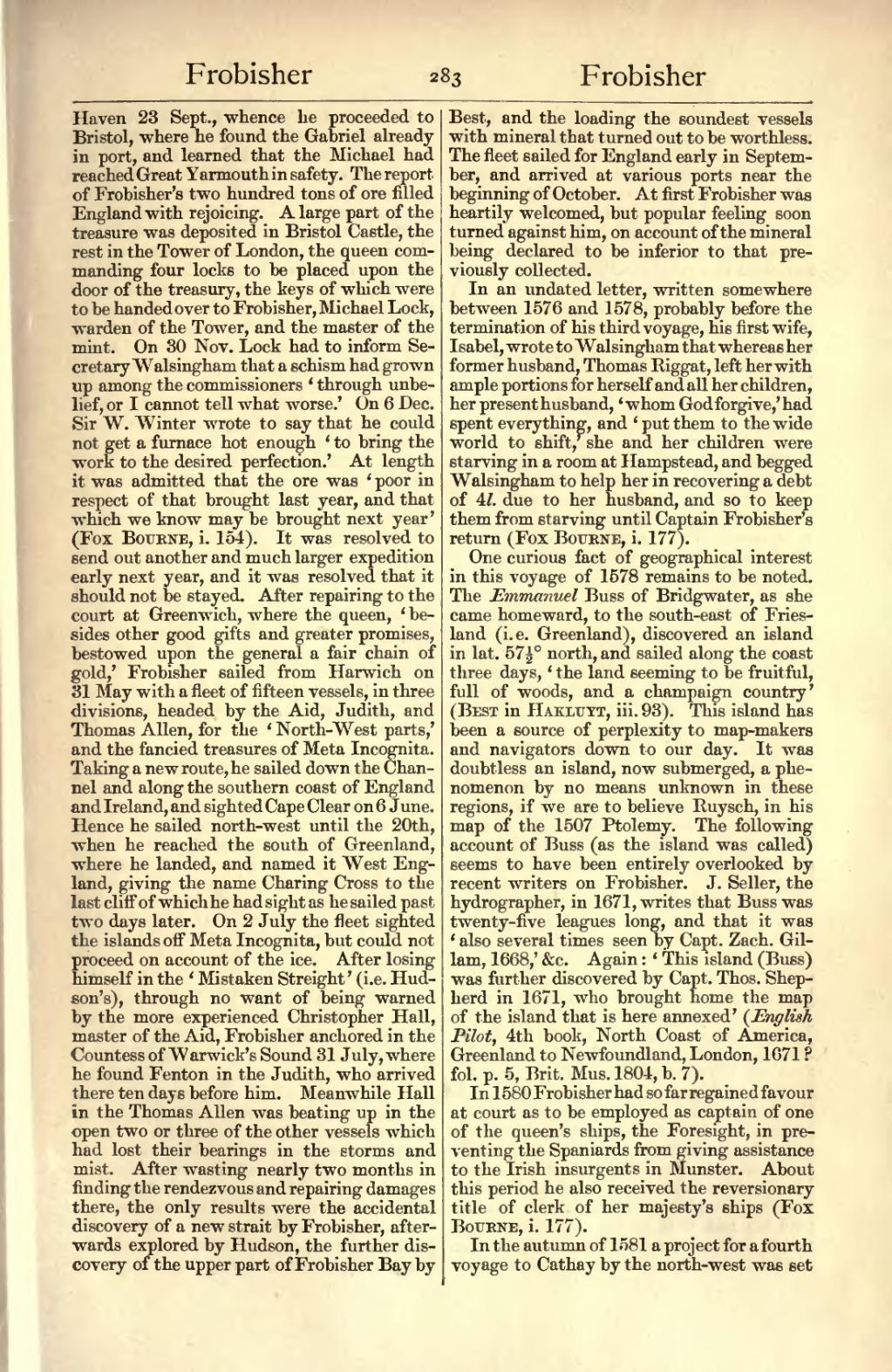Haven 23 Sept., whence he proceeded to Bristol, where he found the Gabriel already in port, and learned that the Michael had reached Great Yarmouth in safety. The report of Frobisher's two hundred tons of ore filled England with rejoicing. A large part of the treasure was deposited in Bristol Castle, the rest in the Tower of London, the queen commanding four locks to be placed upon the door of the treasury, the keys of which were to be handed over to Frobisher, Michael Lock, warden of the Tower, and the master of the mint. On 30 Nov. Lock had to inform Secretary Walsingham that a schism had grown up among the commissioners ‘through unbelief, or I cannot tell what worse.’ On 6 Dec. Sir W. Winter wrote to say that he could not get a furnace hot enough ‘to bring the work to the desired perfection.’ At length it was admitted that the ore was ‘poor in respect of that brought last year, and that which we know may be brought next year’ (Fox Bourne, i. 154). It was resolved to send out another and much larger expedition early next year, and it was resolved that it should not be stayed. After repairing to the court at Greenwich, where the queen, ‘besides other good gifts and greater promises, bestowed upon the general a fair chain of gold,’ Frobisher sailed from Harwich on 31 May with a fleet of fifteen vessels, in three divisions, headed by the Aid, Judith, and Thomas Allen, for the ‘North-West parts,’ and the fancied treasures of Meta Incognita. Taking a new route, he sailed down the Channel and along the southern coast of England and Ireland, and sighted Cape Clear on 6 June. Hence he sailed north-west until the 20th, when he reached the south of Greenland, where he landed, and named it West England, giving the name Charing Cross to the last cliff of which he had sight as he sailed past two days later. On 2 July the fleet sighted the islands off Meta Incognita, but could not proceed on account of the Ice. After losing himself in the ‘Mistaken Streight’ (i.e. Hudson's), through no want of being warned by the more experienced Christopher Hall, master of the Aid. Frobisher anchored in the Countess of Warwick's Sound 31 July, where he found Fenton in the Judith, who arrived there ten days before him. Meanwhile Hall in the Thomas Allen was beating up in the open two or three of the other vessels which had lost their bearings in the storms and mist. After wasting nearly two months in finding the rendezvous and repairing damages there, the only results were the accidental discovery of a new strait by Frobisher, afterwards explored by Hudson, the further discovery of the upper part of Frobisher Bay by Best, and the loading the soundest vessels with mineral that turned out to be worthless. The fleet sailed for England early in September, and arrived at various ports near the beginning of October. At first Frobisher was heartily welcomed, but popular feeling soon turned against him, on account of the mineral being declared to be inferior to that previously collected.
In an undated letter, written between 1576 and 1578, probably before the termination of his third voyage, his first wife, Isabel, whom he married 30 May 1559, wrote to Walsingham that whereas her former husband, Thomas Rickard of Snaith, left her with ample portions for herself and all her children, her present husband, ‘whom God forgive,’ had spent everything, and ‘put them to the wide world to shift,’ she and her children were starving at Hampstead, and begged Walsingham to help her in recovering a debt of 4l. due to her husband, and so to keep them from starving until Captain Frobisher's return (Fox Bourne, i. 177).
One curious fact of geographical interest in this voyage of 1578 remains to be noted. The Emmanuel Buss of Bridgwater, as she came homeward, to the south-east of Friesland (i.e. Greenland), discovered an island in lat. 57½° north, and sailed along the coast three days, ‘the land seeming to be fruitful, full of woods, and a champaign country’ (Best in Hakluyt, iii. 93). This island has been a source of perplexity to map-makers and navigators down to our day. It was doubtless an island, now submerged, a phenomenon by no means unknown in these regions, if we are to believe Ruysch, in his map of the 1507 Ptolemy. The following account of Buss (as the island was called) seems to have been entirely overlooked by recent writers on Frobisher. J. Seller, the hydrographer, in 1671, writes that Buss was twenty-five leagues long, and that it was ‘also several times seen by Capt. Zach. Gillam, 1668,’ &c. Again: ‘This island (Buss) was further discovered by Capt. Thos. Shepherd in 1671, who brought home the map of the island that is here annexed’ (English Pilot, 4th book, North Coast of America, Greenland to Newfoundland, London, 1671? fol. p. 5, Brit. Mus. 1804, b. 7).
In 1580 Frobisher had so far regained favour at court as to be employed as captain of one of the queen's ships, the Foresight, in preventing the Spaniards from giving assistance to the Irish insurgents in Munster. About this period he also received the reversionary title of clerk of her majesty's ships (Fox Bourne, i. 177).
In the autumn of 1581 a project for a fourth voyage to Cathay by the north-west was set
